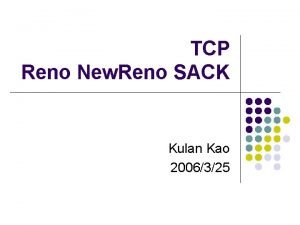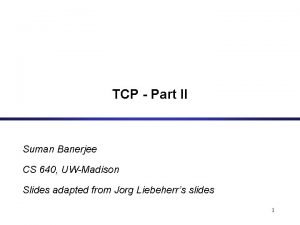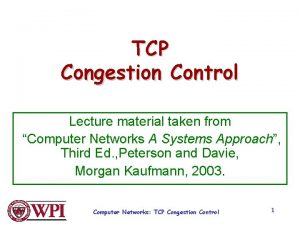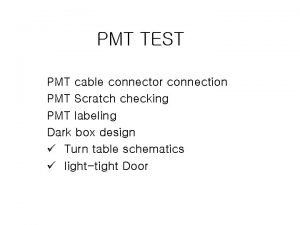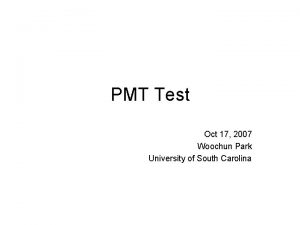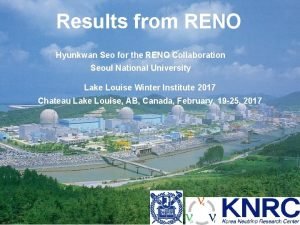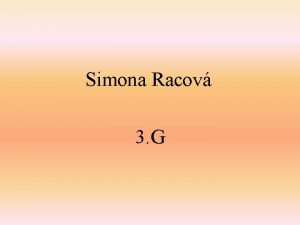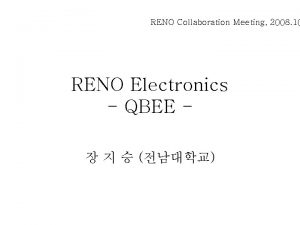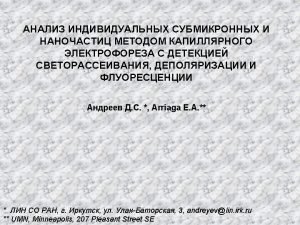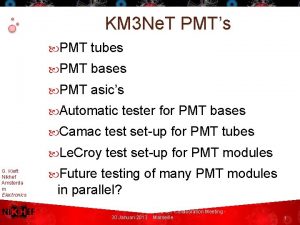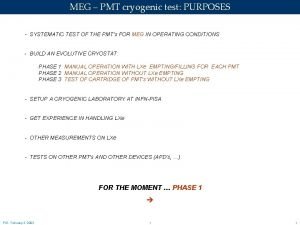RENO PMT TEST Kyung Ju Ma 2007 Oct





![Gain dependence of temperature Temp. . [o. C] Mean Error[±] 2. 9 1. 21 Gain dependence of temperature Temp. . [o. C] Mean Error[±] 2. 9 1. 21](https://slidetodoc.com/presentation_image_h2/48b0a4fd7bfbc2e696c8eaa2f567a247/image-6.jpg)












- Slides: 18

RENO PMT TEST Kyung Ju Ma, 2007. Oct. 6 RENO Collaboration meeting Ø ü ü Ø PMT type DAQ setup Single Photon Electron Resolution Dark Current After Pulse Ratio with two methods Summary


8” and 10” PMTs Hamamatsu R 5912 Signal from XP 1806 Photonis XP 1806 Hamamatsu R 7081

DAQ SETUP R 5912, XP 1806 -data taking Hp pulse/function generator 8116 A PMT set with ice water & Dark Box 100 Mhz, FADC Module(shaped)

Single Photon Electron Resolution Ø Clear single photon electron peak R 7081 116 [m. V] 61. 5 [m. V] ※ qtot ∝ Charge of SPE Peak-to-Valley gain SPE charge [p. C] R 5912 ~4 ~107 (1300 V) 24. 0 Xp 1806 ~4 ~107 (1550 V) 12. 3
![Gain dependence of temperature Temp o C Mean Error 2 9 1 21 Gain dependence of temperature Temp. . [o. C] Mean Error[±] 2. 9 1. 21](https://slidetodoc.com/presentation_image_h2/48b0a4fd7bfbc2e696c8eaa2f567a247/image-6.jpg)
Gain dependence of temperature Temp. . [o. C] Mean Error[±] 2. 9 1. 21 x 102 1. 50 14. 3 1. 16× 102 0. 98 24. 5 1. 14× 102 2. 32

Dark Current Temperature Dependence(R 5912) Ø RENO expected Dark Current at 10 ~ 15 o. C is ~ 6 K/s Ø 6~10 K/s are measured for the expected region which are more higher than expected. Ø For the steep increase at 14 ~ 15 o. C, the spent time after closed dark Box having been considered.

Dark Current Temperature Dependence(R 7081) Ø linear dependence Øshow 8 K/s for the region of 10 ~15 o. C Ø more higher than R 5912 and XP 1806

Dark Current Temperature Dependence(XP 1806) Ø linear dependence Ø show 2 ~ 3 K/s for the region of around 10 o. C

After Pulse Ratio using accumulated Method(R 5912) Ø First After Pulse Ratio = 1. 88 % Ø Second After Pulse Ratio= 3. 65 %

After Pulse Ratio using accumulated Method(XP 1806) Ø First After Pulse Ratio =3. 26 % Ø Second After Pulse Ratio=2. 47 %

After Pulse Ratio using accumulated Method(R 7081) Ø First After Pulse Ratio =2. 57 % Ø Second After Pulse Ratio=2. 91 %

Probability (No. of SPE /0. 1. micro. sec. ) Pulse Ratio using clustering Method(R 5912) 0. 7 micro. Sec. 1. 7 micro. Sec. 6. 7 micro. Sec. ⅹ 10 ns Ø After Pulse Ratio = 2. 6 ~3. 9 % Ø After Pulse peaks are occurred after 0. 7, 1. 7 and 6. 7 micro second. (Primary signal region (1300, 1360)

Probability (No. of SPE /0. 1. micro. sec. ) Pulse Ratio using clustering Method(xp 1806) 1. 2 micro. Sec. ⅹ 10 ns 6. 7 micro. Sec. Ø After Pulse peaks are occurred after 1. 2 and 6. 7 micro second. (Primary signal region (1310, 1350)

Probability (No. of SPE /0. 1. micro. sec. ) Pulse Ratio using clustering Method(R 7081) 0. 7 micro. Sec. 6. 7 micro. Sec. ⅹ 10 ns Ø After Pulse Ratio = 2. 1 ~2. 6 % Ø After Pulse peaks are occurred after 0. 7 and 6. 7 micro second. (Primary signal region (1010, 1050)

After Pulse Ratio using the clustering Method Ø Both PMT show 2 ~ 3 % which is correspond to the PMT specification Ø After Pulse don’t show temperature dependence. it has been known and convinced

SUMMARY Ø Tested PMT: Hamamatsu PMT(8 inch-R 5912, 10 inch-R 7081), Photonis PMT(8 inch XP 1806) Ø DAQ setup: 100 Hz FADC, PMT set with ICE water, 10 ns width Pulse generator Ø R 5912, r 7081 show the clear single photon electron resolution. Ø Gain and Dark Current show the temperature dependence. Ø Dark Currents are 6~10 K/s(R 5912), 8 K/s(R 7081), 2~3 K/s(XP 1806) for the temp. range(10~15 o. C) Ø After Pulse Ratio(APR) was tested using two method (Accumulating, Clustering ). - APR by Clustering Method for R 5912, XP 1806 and R 7081 show 2 ~ 3 % which is correspond to the PMT specification - APR by Accumulated metod for R 5912, XP 1806 and R 7081 show 5 ~5. 7 % which is correspond to the PMT specification Ø R 5912, XP 1806 and R 7081 have typical After Pulse shape as show fixed After Pulse time region after Primary Signal. Ø After Pulse don’t show temperature dependence.

NEXT STEP Ø XP 1806 base noise problem fix and single photo electron resolution study. Ø Dark Current dependence on Spending time (after Dark Box closing, after HV turn on) and temperature. Ø study about the different result for After Pulse Ratio by Accumulated method and Clustering method.
 Pmt function in excel 2007
Pmt function in excel 2007 Kyung hee university mba
Kyung hee university mba Captain kyung
Captain kyung Network layer
Network layer Kyung hee university hospital at gangdong
Kyung hee university hospital at gangdong Html q
Html q Tcp reno rfc
Tcp reno rfc Tahoe vs reno
Tahoe vs reno New reno
New reno Tcp reno fast recovery
Tcp reno fast recovery Tahoe vs reno
Tahoe vs reno Reno computer networking
Reno computer networking Tcp slow start
Tcp slow start Dr jack soaring
Dr jack soaring Unione reno galliera cruscotto
Unione reno galliera cruscotto El reno path
El reno path What is duplicate acknowledgement in tcp
What is duplicate acknowledgement in tcp Sparks police report
Sparks police report Liceo vinci casalecchio
Liceo vinci casalecchio






